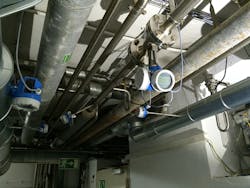Alternatives to installing flowmeters to specified straight run
In my recent columns, I suggested that many flowmeters are affected by the velocity profile of the fluid upstream of and/or downstream from the flowmeter. One approach to developing a good velocity profile is to install flowmeters with sufficient straight run as specified by the flowmeter manufacturer.
This approach sounds good on paper, but in many installations, adequate space may not be available to install the specified straight run. Also, modifying the design to accommodate the specified straight run is often expensive or impossible. Still, some practical options exist.
For example, a flowmeter requiring 15 diameters of upstream straight run and 5 diameters of downstream straight run must be installed in a piping run that is 15 diameters long. You could install the flow meter with 10 diameters upstream and 5 diameters downstream. However, most flowmeter designs are more affected by their upstream straight run than their downstream straight run. Therefore, reducing the downstream straight as much as is practical can increase the upstream straight run — perhaps with 13 to 13.5 diameters upstream and 1.5 to 2 diameters downstream in this example.
Sometimes more straight run is available, such as when the flow meter in this example can be installed for a piping run that is 30 diameters long. The flowmeter would look nice and meet the manufacturer’s specifications if it were installed with 15 diameters upstream and 15 diameters downstream. However, locating the flowmeter 20 to 25 diameters upstream and 5 to 10 diameters downstream might be more pragmatic considering that piping configurations in the field rarely match piping configurations tested by the manufacturer.
These applications illustrate ways to partially mitigate the effects of a poor situation (insufficient straight run) and how to make the best of a good situation (more than sufficient straight run), respectfully. Similar opportunities are rampant in the process industries — if you understand what is happening and know where to look.
David W. Spitzer
David W. Spitzer is a regular contributor to Flow Control magazine and a principal in Spitzer and Boyes, LLC, offering engineering, seminars, strategic, marketing consulting, distribution consulting and expert witness services for manufacturing and automation companies. Spitzer and Boyes is also the publisher of the Industrial Automation INSIDER. Spitzer has more than 40 years of experience and has written more than 10 books and 300 articles about flow measurement, instrumentation and process control. He may be reached at 845-623-1830 or spitzerandboyes.com. Click on the "Products" tab to find his Consumer Guides to various flow and level measurement technologies.
About the Author
David W. Spitzer
David W Spitzer’s new book Global Climate Change: A Clear Explanation and Pathway to Mitigation (Amazon.com) adds to his over 500 technical articles and 10 books on flow measurement, instrumentation, process control and variable speed drives. David offers consulting services and keynote speeches, writes/edits white papers, presents seminars, and provides expert witness services at Spitzer and Boyes LLC (spitzerandboyes.com or +1.845.623.1830).

